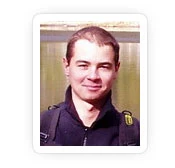What is Nutation and How Can It Help Our Forward Bends? Part 1

Many moons ago I had the privilege of spending an extended period studying yoga at the Ramamani Iyengar Memorial Yoga Institute in Pune, India. During my time there I made it a point to watch Yogacharya Iyengar practice whenever possible.
I not only observed the form of his body but also the way he practiced, how he moved from one pose to another, and the way he worked in the individual asanas. I was fascinated by how he continued to refine his art. Bear in mind that B.K.S. Iyengar is the author of Light on Yoga, and he had been practicing for over 50 years at the time. Still, like a master artist, he polished his poses as if his body were a dynamic sculpture.
 One day, as fate would have it, I was the only other person in the practice hall and Master Iyengar was going through his backbend sequence (picture the most advanced backbends from Light on Yoga to get an idea).
One day, as fate would have it, I was the only other person in the practice hall and Master Iyengar was going through his backbend sequence (picture the most advanced backbends from Light on Yoga to get an idea).
I sat on the staircase and watched. He finished, and as he was getting dressed asked if I would like to go with him to visit some people around the city. The next thing I knew, I was in the back of a car speaking with Mr. Iyengar. I mentioned that he still worked to improve his poses, even though he was a master of the art. He gave me a somewhat surprised look as if to say, “Of course I am!”
This is a characteristic of masters in any discipline. Even when they have achieved excellence, they still look for incremental improvement. One of the great things about yoga is that we can always work to improve our postures. In this article, we use Uttanasana to illustrate this technique.
(The above image shows Sacral Nutation (click here to see sacral nutation motion – exaggerated for effect))
(The above image shows Anterior (front) and posterior (back) views of the sacroiliac joint with ligaments.)
Nutation in Forward Bends
The sacroiliac joint is one of the most stable in the body due to the stout ligaments that surround it. It doesn’t move much—some say it doesn’t move at all.
The movement that is available is called “nutation,” which means nodding (as in nodding your head). In nutation, the sacrum tilts forward just a little bit between the iliac crests. We can use this movement to deepen forward bends such as Uttanasana. This adds some incremental forward bending from within the pelvis, rather than the lumbar spine, and aids to protect the spine from hyperflexion.
The Tensor Fascia Lata, the Gluteus Medius and Uttanasana
Now, let’s look at how to use the tensor fascia lata and gluteus medius muscles to create some opening for movement that can incrementally deepen your forward bends, especially Uttanasana.
 (The image on the left shows freeing the sacroiliac joint using the gluteus medius and tensor fascia lata.)
(The image on the left shows freeing the sacroiliac joint using the gluteus medius and tensor fascia lata.)
The tensor fascia lata (TFL) and gluteus medius are muscles at the sides of the pelvis. The TFL originates from the front of the iliac crest and inserts onto the iliotibial band and from there onto the outside of the front of the tibia. The gluteus medius originates a bit farther back on the iliac crest and inserts onto the greater trochanter at the top of the femur (thigh bone).
The main action of these muscles is the abduction of the hip (taking the leg out to the side away from the midline). The TFL and the more anterior (front) fibers of the gluteus medius also internally rotate the femur. If the femurs are fixed in place (by constraining the feet to the mat), then activating these muscles pulls on their origins at the iliac crest, creating a degree of mobility at the sacroiliac joint.
This is an example of “closed chain” contraction, wherein engaging a muscle moves the origin rather than the insertion (moving the insertion is considered “open chain” contraction).
In Uttanasana, firmly press the feet into the mat and then gently attempt to drag them apart (without actually allowing them to move). This is a cue to activate the TFL and gluteus medius. These muscles then pull on the iliac bones and free the sacroiliac joints, allowing that extra millimeter of forward bend from counter nutation.
Remember to go slowly when applying these techniques. It is not necessary to use strong muscular contractions to experience the benefits. Start with gentle force and learn to moderate the contraction, “dialing” it in. Use similar care as you gradually release the action of the muscles. This applies to using the shoulders as well–gentle contraction and release.
Stay tuned for the next post, when we’ll illustrate a fringe benefit of engaging the tensor fascia lata and gluteus medius to counteract the kneecaps rolling outward in forward bends.
Interested in more anatomy articles by Dr. Ray Long? Check out this one on Plantar Fasciitis.
Printed with permission from TheDailyBandha.com

Author, Ray Long MD FRCSC is a board-certified orthopedic surgeon and the founder of Bandha Yoga. Ray graduated from The University of Michigan Medical School with post-graduate training at Cornell University, McGill University, The University of Montreal and Florida Orthopedic Institute. He has studied hatha yoga for over twenty years, training extensively with B.K.S. Iyengar and other leading yoga masters.
 3d Graphic Designer / Illustrator Chris Macivor has been involved in the field of digital content creation for well over ten years. He is a graduate of Etobicoke School of the Arts, Sheridan College and Seneca College. Chris considers himself to be equally artistic and technical in nature. As such his work has spanned many genres from film and television to videogames and underwater imagery.
3d Graphic Designer / Illustrator Chris Macivor has been involved in the field of digital content creation for well over ten years. He is a graduate of Etobicoke School of the Arts, Sheridan College and Seneca College. Chris considers himself to be equally artistic and technical in nature. As such his work has spanned many genres from film and television to videogames and underwater imagery.




